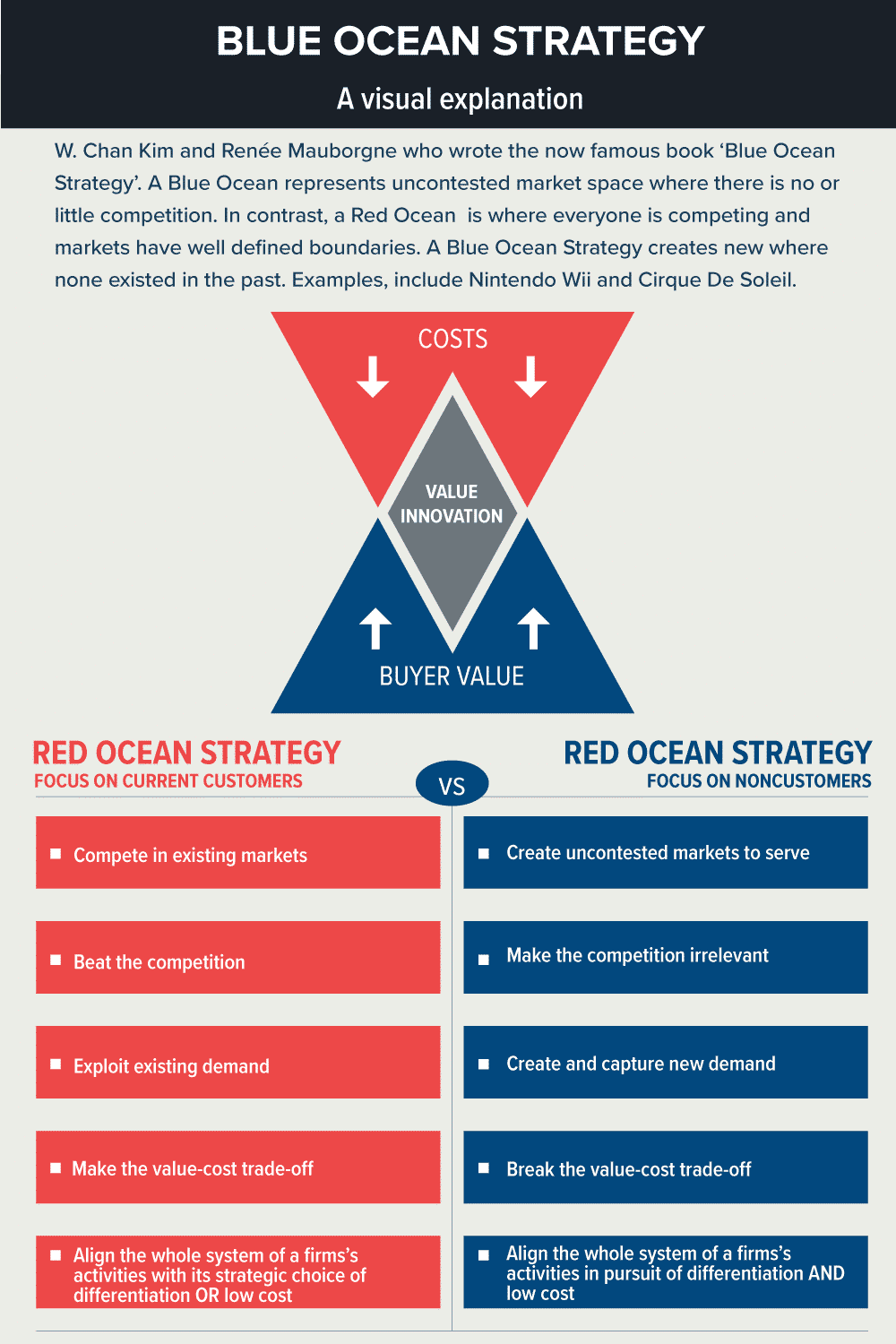The Blue Ocean Strategy is a strategic framework, mindset and method that you can use to create new markets where there is no competition.
In this article, I’ll take you what is a blue ocean strategy? the fundamentals of a blue ocean strategy and how to use the blue ocean strategy to identify exploit new market opportunities.
Table of Contents
The Quick Summary
Most companies compete in tightly defined markets and continually fight for a limited amount of value available. Over time, margins and opportunities erode as costs associated with improving market share or profits outweigh returns – these are red oceans.
The Blue Ocean framework is a strategic approach that how companies can create new markets where there is little or no competition and therefore they can earn above-average profits. The blue ocean takes you from market competing to market creating.
Why use it? A good way to understand how to reassess strategic options. It encourages leaders to change their mindset and adopt a design approach to strategy. It’s the difference between business process reengineering (BPR) and business design. BPR focuses on improving current position in an existing market by transforming internal processes but maintains strategic trajectory. Business design and blue ocean provides a framework for leaders to rethink the trajectory of the business.
Who should use it? Leadership teams that have identified:
- their portfolio of products services is being eroded.
- new and innovative new startups or competitive products/services.
- new and emerging technologies that offer possibilities to dramatically disrupt their market.
What are some examples: Cirque De Soleil, Nintendo Wii, National Youth Orchestra of Iraq, Nescafe Nespresso
What is a Blue Ocean Strategy?
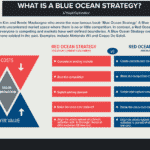
Blue Ocean Strategy is a concept developed by INSEAD professors W. Chan Kim and Renée Mauborgne. A Blue Ocean Strategy focuses on creating and exploiting new market spaces – ‘blue oceans’, rather than going head to head in fiercely competitive markets, red oceans.
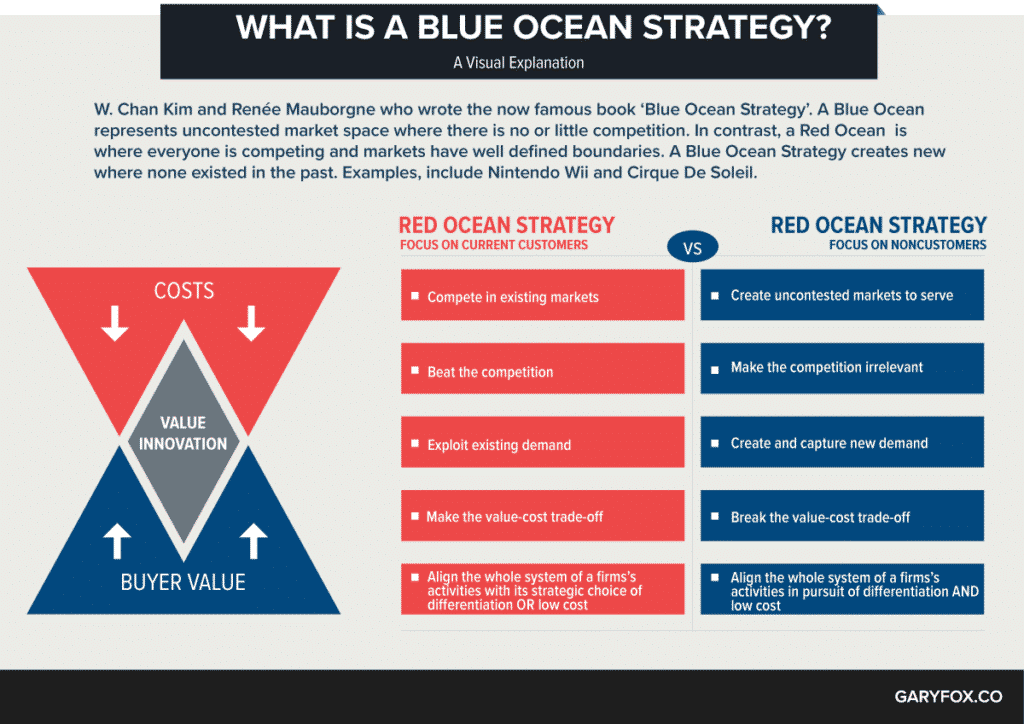
Markets or “blue oceans” are created by value innovation and at the same time driving down costs. These combined strategies effectively beat the competition or in their own words “make the competition irrelevant“. In other words, the key to success is to find a market that you can create and then make your own.
Blue Ocean Strategy Definition and Fundamentals
The term ‘Blue Ocean’ comes from the now famous book by professors W. Chan Kim and Renee Mauborgne in their book Blue Ocean Strategy: How to Create Uncontested Market Space and Make the Competition Irrelevant.
The appeal of this message propelled the book into the bestseller list and it has subsequently sold over 4 million copies and be translated into over 40 languages.
In their research on new ventures, W. Chan Kim and Renee Mauborgne studied 150 strategic moves across 30 industries across 100 years. They analyzed new business launches in 108 companies and found that 86% of these new ventures were merely line extensions and only 14% actually created new markets or industries.
What was more astonishing though was that although the line extensions accounted for 62% of total revenues, they only delivered only 39% of total profits. In comparison, the new markets or industries accounted for 61% of the profits.
The main concept is that profits and growth come from creating new products and services in uncontested markets – the “blue oceans”. Whereas, the conventional business strategy focuses on competing inside an existing “red oceans” and trying to beat the competition.
The Blue Ocean Strategy is a useful framework for leadership teams and can facilitate ideas and development of new initiatives.
If a company is under siege with its market being infested with more and more competitors, then the blue ocean strategy can provide the impetus to change direction.
What Are Red Oceans?
Red Oceans represent all the industries and markets in existence today. As an example, all the existing companies that are in a known market space such as chocolate manufacturers. According to the authors they all share the same characteristics and fate.
The characteristics of Red Oceans are that they are crowded, lack the potential growth, margins are constantly eroded resulting in commoditization. The term Red Ocean comes from the idea that the ferocity of the competition leads to bloody battles over profits…in other words like sharks fighting over a carcass.
Red Oceans are defined by:
- competing for customers in existing markets.
- need to strategically fight against tough competition.
- exploiting existing demand by using line extensions, bundling products…
- make the value-cost trade-off – promote products to try and improve market share, offer discounts and cost reductions or try and improve value offer without incurring additional costs.
What Are Blue Oceans?
Blue oceans denote all the industries not in existence today. This is the unknown market that is based on stop trying to beat others and is focused on developing new values.
Blue Oceans are defined by:
- maximizing the value of offerings within the boundaries of the industry.
- adapting to external trends (Porters Five Forces).
- improving price-performance within the functional/emotional appeal of its industry.
- better serving the buyer group.
- competitors within an industry.
- having a competitive position within strategic group
Blue Ocean vs Red Ocean Strategy
The red ocean strategy takes a structuralist view of the market where all parties accept predefined structures within an industry and continue to compete within these. The red ocean strategy takes a structuralist view of the market where all parties accept predefined structures within an industry and continue to compete within these. To sustain this competition, companies focus on building advantages over their competition. All gains are at the loss of another company and wealth is captured and redistributed instead of being created.
The blue ocean strategy is a reconstructionist view of the market where no accepted boundaries or structure is present. The structure can be created or recreated by the steps taken by players in the market. Strategy and thinking is not limited by preconceived barriersStrategy and thinking is not limited by preconceived barriers, and a shift happens from a focus on the supply side to a focus on the demand side. Value innovation takes precedence over competing blindly with a simultaneous focus on differentiation and cost effectiveness.
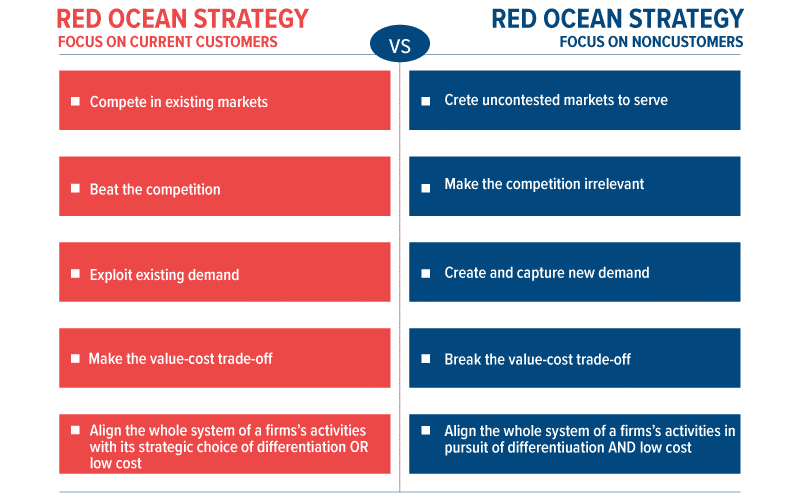
Porter vs Blue Ocean Strategy
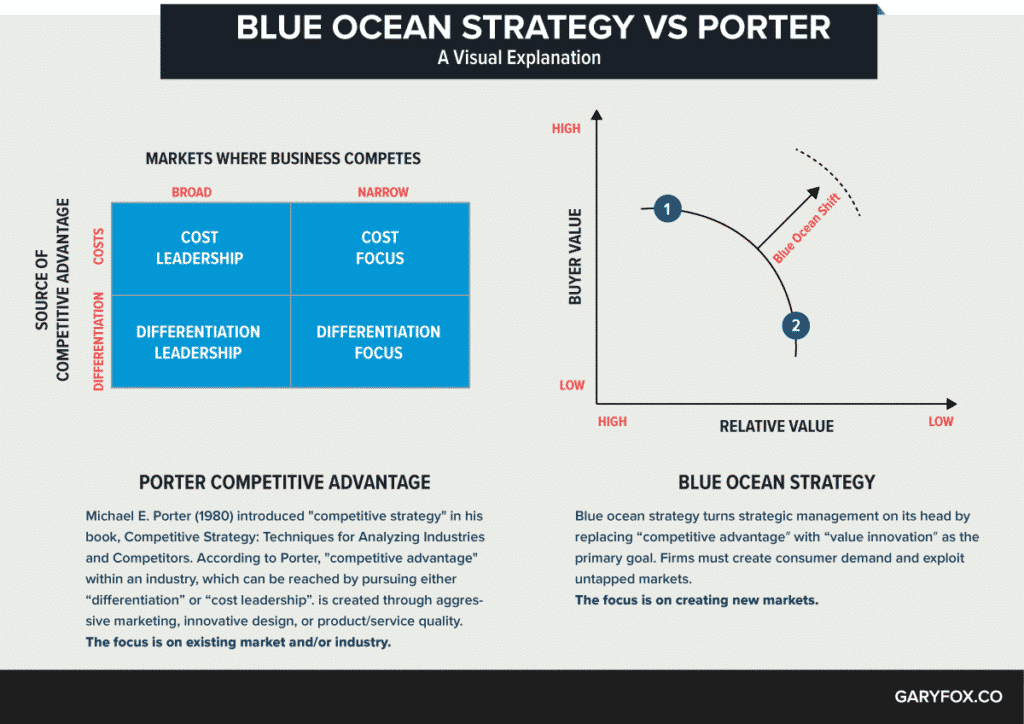
Porter’s model focuses on developing a strategic framework that starts with analysing the external environment – Porters Five Forces model.
Porter’s five forces analysis provides the insight into the intensity of competition, potential profitability and attractiveness of an industry. The analysis focuses within the industry and market and so is limited to the existing value propositions and profit opportunities.
The Blue Ocean Strategy is an approach to innovate value and create new market space, tap into unsatisfied consumer demand, and find uncontested market space. As a result, competition becomes irrelevant because the rules of the game are yet to be set.
The New Blue Ocean Strategy Book – Updates
In the new and updated version of the Blue Ocean Strategy book, the authors have added several more examples and given some valuable insights into how companies have successfully implemented this strategy framework.
Companies that successfully implement Blue Ocean strategies have the following in common:
- Mindset
- Tools
- Culture
Mindset
Research has repeatedly shown that companies have a culture and way of viewing the world that reinforces how they then organize and do business. It is often referred to as the dominant logic in a company – a way of viewing the company, market and customer. the problem is that this can become outdated or dangerously narrow.
The Blue Ocean approach requires leaders to expand their mental horizons, in much the same way as designing a business model. Developing new mental models and challenging the existing business logic within the industry is critical. In the guide below I provide the first steps to developing a blue ocean strategy along with the tools to use.
Tools
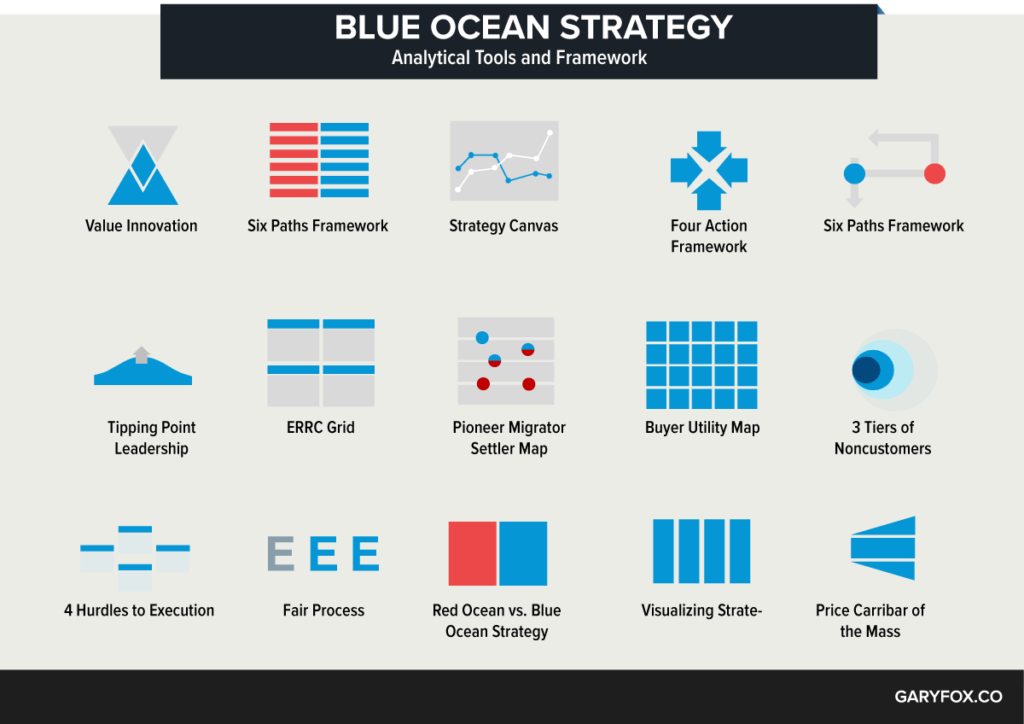
To successfully implement blue ocean thinking you need to have the right toolkit and process. The tools aligned to the framework and process are a powerful way to systematically identify blue ocean strategies. Once teams are familiar with the tools, the shift in mindset becomes easier and the process becomes embedded in the way of creatively framing opportunities.
Overcoming Mental Barriers
“Recognizing that structure and market boundaries exist only in managers’ minds, practitioners who hold this view do not let existing market structures limit their thinking. ”
Source: Blue Ocean Strategy
Organizations to regular look for new ways to renew their value. New technologies present endless ways to create and transform value propositions. However, unless a culture of exploration is developed then the end result will always be ideas and implementations that fall short of value innovation. Practice business design and lead from the front. Encourage teams to confront ambiguous and often difficult challenges when seeking out new ways to innovate.
“If you don’t cannibalize yourself, someone else will.”
Steve Jobs
A common mistake among leaders is the fear of cannibalizing existing market offers. When I talk with leaders I explain that it is better to control your own disruption than be at the mercy of startups and disruptive forces that you have no control over. Change will happen regardless of whether you think it should.
What Is Value Innovation?
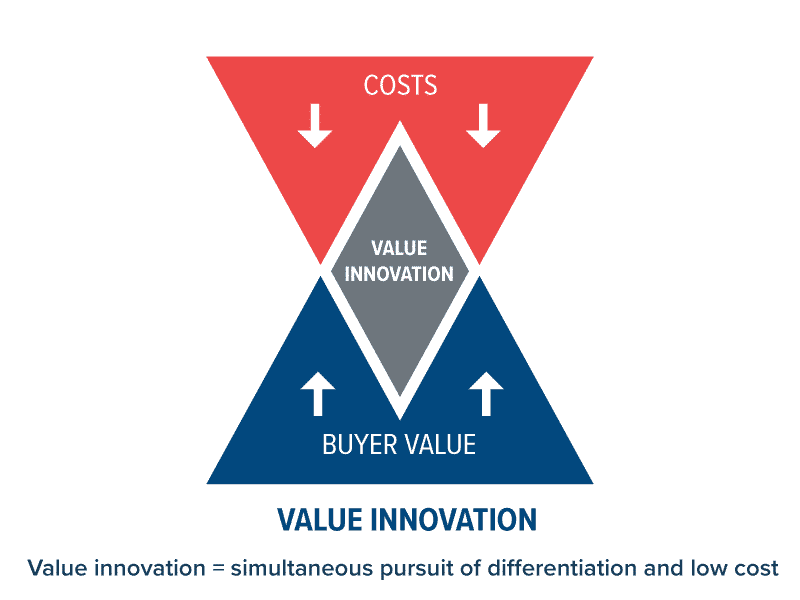
“Value innovation places equal emphasis on value and innovation. Value without innovation tends to focus on value creation on an incremental scale, something that improves value but is not sufficient to make you stand out in the marketplace.”
Source: Blue Ocean Strategy
Value innovation is as important as technology innovation. When companies obsess about technologies and the ‘value’ it can deliver they often forget the core principles of understanding what problem they are addressing for the customer – how the solution addresses their needs and relative to others.
The blue ocean strategy fundamentally challenges leaders to assess the value rather than the technology. To map current value propositions and then to create innovative new value.
Value innovation is the cornerstone of Blue Ocean Strategy. It rejects the principles of trading low cost vs value proposed by Michael Porter.
The authors advocate that a company can offer its customers value at a low cost, overcoming the value-cost trade-off by pursuing low costs and differentiation. This is called ‘value innovation’ which in turn leads to high growth and profits.
Blue Ocean Strategy Examples
What is an example of a Blue Ocean Strategy?
There are lots of good examples such as Cirque Du Soleil, Often you can see breakthrough innovation happening across different industries and the emergence of value innovation.
Cirque du Soleil and the Blue Ocean Strategy

Cirque du Soleil or Circus of the Sun is the largest theatrical company in the world. The original founders of this spectacular entertainment company were two former street performers Guy Laliberté and Gilles Ste-Croix. The company’s theatrical and character-driven focus has helped it reach a global audience and receive numerous awards. The circus has held shows in over 271 countries and has an estimated annual revenue of over $900M.
“Cirque du Soleil offers the best of both circus and theater, and it has eliminated or reduced everything else. ”
Source: Blue Ocean Strategy
Cirque du Soleil Value Innovation
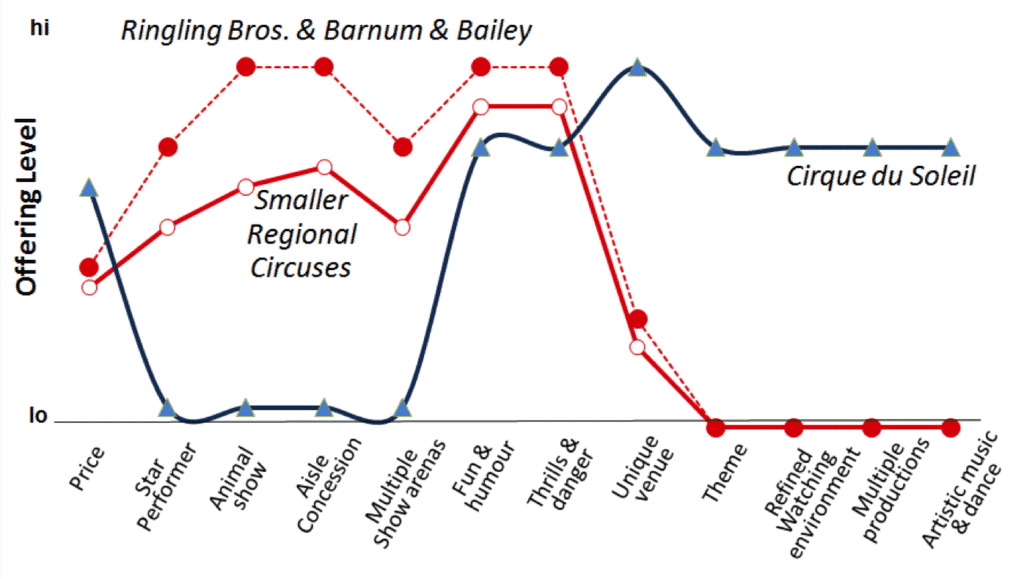
Cirque Du Soleil eliminated those elements of the circus that created low value with the customer but were high cost. These included the costly three-ring method, the use of trained animals.
Instead, they created a sophisticated theatrical production with a unique storyline and characters. As a result, the company managed to offer new value elements of the theatre combined with the drama of the circus. They effectively created a new genre of entertainment and then proceeded to develop a unique business model to expand and scale their operations internationally.
Nintendo Wii and the Blue Ocean Strategy
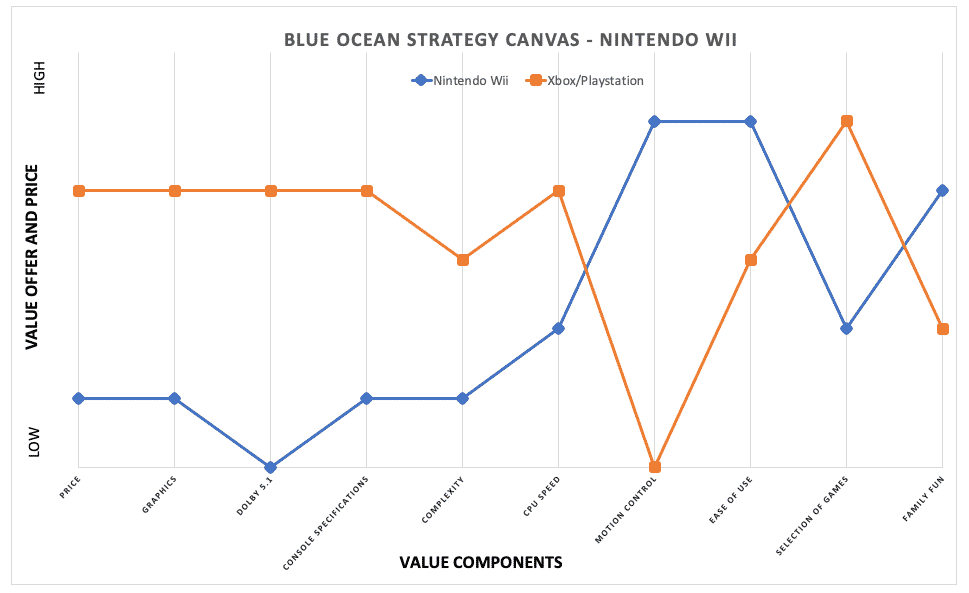
The Wii was a sensation when it was by Nintendo in November 2006. Compared to other game consoles (Sony Playstation and Xbox) it was unique because of the focus on motion. Unlike other consoles, the Wii used a small handheld device to detects movement in 3D which allowed users to interact in new ways within games.
The strategy canvas demonstrates that Nintendo designed the Wii to compete on different value components than Sony Playstation and Microsoft Xbox. The Wii cost less, had no Hard Disk, no DVD, no surround sound capabilities (Dolby 5.1), weak connectivity and comparatively low specification processor.
However, the motion control stick which mimicked the movements of a player transported the player into the video game and appealed to games that previously were very difficult on a console e.g. tennis, golf, sword fights…
How To Use The Blue Ocean Strategy – A Quick Guide
The book presents a five-step process to systematically develop a Blue Ocean initiative. The five steps are:
- Choose the right place to start and create a core team.
- Analyse and gain clarity about the current business environment and competition.
- Analyse the hidden problems that limit the current size of the industry and discover an ocean of non-customers.
- Systematically reconstructing market boundaries and developing alternative Blue Ocean opportunities.
- Selecting the right Blue Ocean move, conducting rapid market tests, finalizing, and launching the shift.
How To Use The Blue Ocean Strategy
The Six Principles
The Six Principles of Blue Ocean Strategy are:
- Formulation Principles
- Reconstruct the market boundaries – re-define the market space
- Focus on the big picture, not the numbers
- Reach beyond existing demand
- Get the strategic sequence right
- Execution Principles
- Overcome key organizational hurdles
- Build execution into strategy
The Boundaries of Competition
- Look across markets: map a wider perspective of how and what buyers are using instead or as an alternative to your product or service.
- Explore groups within markets: examine levels of buying behaviour e.g. for travel there are the following types of groups: luxury, business, economy, family, singles…identify the propositions and why people buy and if they trade up or down.
- Examine the value chain: often in the supply chain, there are people that influence buying behaviour as well as participate with others to create the final solution. Examine how the value is constructed and who influences buying decisions in the market.
- Assess complementary product and service offerings: Instead of just focusing on the immediate purchase and use of the product think about other needs post-purchase or end of life.
- Analyse functional or emotional appeal: A functional product can be enhanced with emotional value and vice versa. As an example, Swatch added emotional connections to their brand and as a result it became a trendy accessory.
- Look across time: Analyze past trends and forthcoming ones that changed a market. How can you see a new trend or technology changing a value dimension?
Step 1. Strategy Canvas
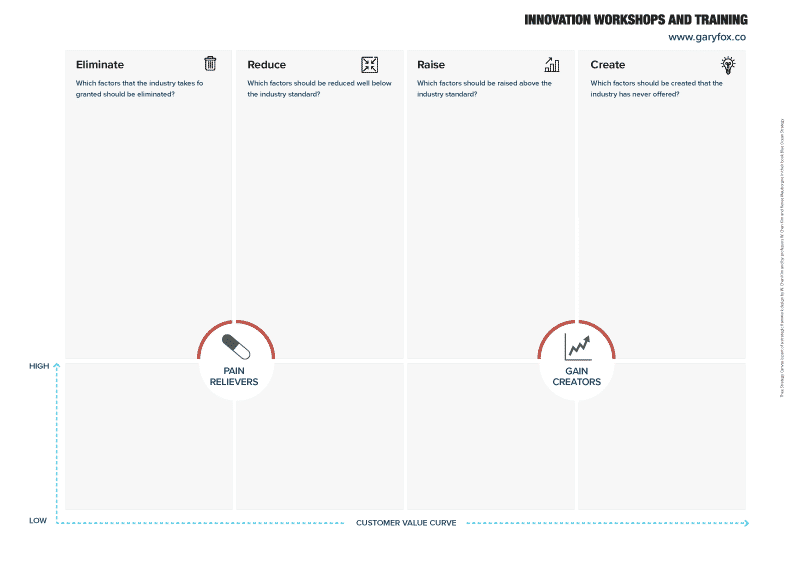
The Strategy Canvas is the cornerstone of the blue ocean strategy. The strategy canvas is used to plot the current main dimensions that are valued by customers and used by you and your competition. Normally there are lots of overlaps between competitors and minor differences in a market.
A strategy canvas is a line graph that plots functions/factors against importance for a company and then adds competitors or industry benchmarks. As a result, the visualization can be used to analyse and formulate a competitive strategy.
The Strategy Canvas is basically an action framework which is represented by a line graph to pinpoint
X-axis – ‘factors of competition’
Y-axis – ‘degree of value to customer’
- Plot on the horizontal axis the current value dimensions (features/services and value propositions) that your company is currently competing in the industry/market. For each factor grade its value from ‘High’ to ‘Low’.
- Plot competitors.
This stage is about identifying and realizing how you and your competitors currently compete.
Key points:
- What is your position?
- What is your competitor’s position?
- How do you differ and where do you converge?
- How significant are the differences?
Step 2. Four Actions Framework
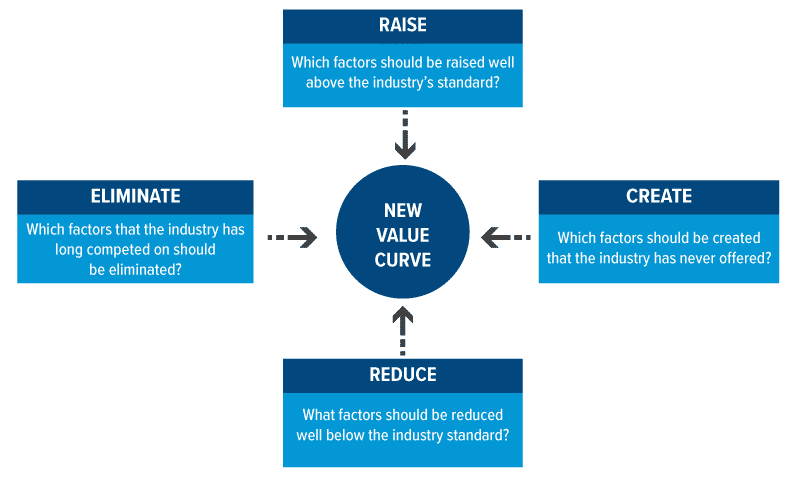
This next step is to experiment and reinvent the opportunities and market space by identifying value innovation opportunities.
Create, Reduce, Eliminate and Raise
To understand more about pains and gains see the article on designing a value proposition.
In a similar way you to understanding customers pain points, you need to go out and explore customer paths.
Based on the Strategy Canvas you can experiment with each feature and do one of the following:
- Raise: Which factors should be raised well above the industry standard?
- Eliminate: Which factors that the industry takes for granted should be eliminated?
- Reduce: Which factors should be reduced well below the industry standard?
- Created: Which factors should be created that the industry has never offered?
Step 3. Reach Beyond Existing Customers
Three Tiers of Non-Customers is a mental framework for exploring how to reach non-customers and pull them into a new market.
- Your Market
- First Tier – “Soon to be” non-customers who are on the edge of your market – buy minimally and decide to not participate fully in the market.
- Second Tier – “Refusing” non-customers who see and understand offer but decide not to buy and use alternatives.
- Third Tier – “Unexplored” non-customers who are in markets distant from yours and have never considered the market’s offer as an option.
Step 4. Classify The Different Products/Services/Business Units in Your Company
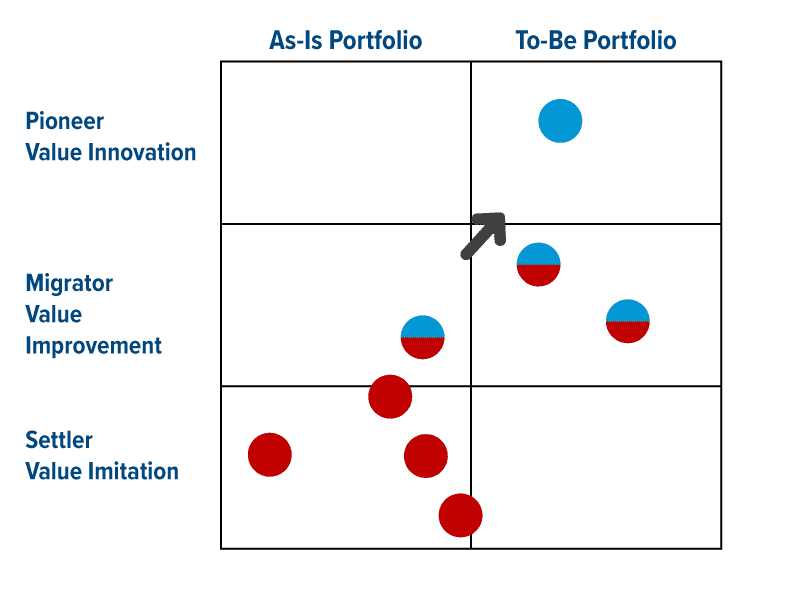
The process is designed to change the mindset, understanding and move beyond the current limitations of the existing industry (“settlers”) and identify greater value improvement (“migrators”) and then progressively move to value innovation by identifying noncustomers (the “pioneers” of marketing-creating innovation.)
blue ocean strategy summary
Limitations of Blue Ocean Strategy
There is generally less in terms of large-scale quantitative evidence to back up their claims. It should be noted that Kim and Mauborgne (2005b, p. 8) admit the limitations of their data: “Although we don’t have data on the hit rate of success of red and blue ocean initiatives, the global performance differences between them are marked.”
Ultimately Blue Ocean strategy is about a developing and cultivating a different mindset.
Related Models
- Disruptive innovation (Clayton Christensen)
- Business model innovation (Chesbrough 2010, Johnson 2010)
Free Blue Ocean Strategy Templates
There are two blue ocean strategy pdf templates included in the free download, an excel sheet you can use to create a strategy canvas and a Microsoft PowerPoint.
